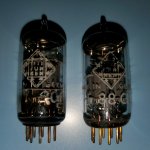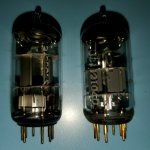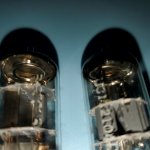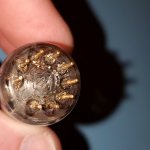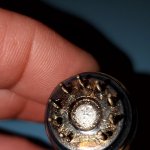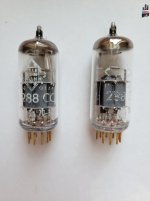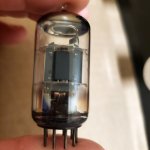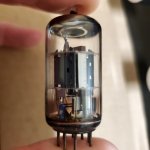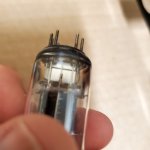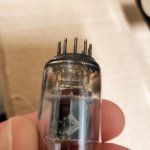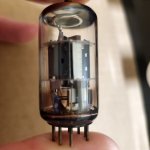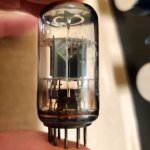Hi all!
I recently acquired a project preamp without documentation which uses sixpentodes dual triodes (two in phono stage plus four in linestage).
I assumed all would be the same E88CC, and prior to turning it on, proceded to test the tubes on my TV-7U/D. Four are Telefunken, one Siemens, and one sans-branding (likely Chinese).
When I began testing, two showed no conductivity for both triode sides, which led me to question whether they were in fact E88CCs. Of course they lack markings other than the Telefunken diamond and country of manufacture.
What's odd is that the two mystery tubes were not in the phono stage, but instead within the linestage section, which relies on matched pairs for the two channels.
Attached is a comparison of the tube in question as well as a known, labeled Telefunken E88CC. The known E88CC has a getter plate supporting the halo post, whereas the tube in question does not. I'm not familiar enough with 9-pin tubes - much less Telefunken models to identify whether this is just another variant or a different tube altogether, so pitching this out to the experts 😉.
In the attahed images, the known E88CC is the one with gold pins and the mirror image of the number "11" inside its diamond on the underside.
Thanks!
I recently acquired a project preamp without documentation which uses six
I assumed all would be the same E88CC, and prior to turning it on, proceded to test the tubes on my TV-7U/D. Four are Telefunken, one Siemens, and one sans-branding (likely Chinese).
When I began testing, two showed no conductivity for both triode sides, which led me to question whether they were in fact E88CCs. Of course they lack markings other than the Telefunken diamond and country of manufacture.
What's odd is that the two mystery tubes were not in the phono stage, but instead within the linestage section, which relies on matched pairs for the two channels.
Attached is a comparison of the tube in question as well as a known, labeled Telefunken E88CC. The known E88CC has a getter plate supporting the halo post, whereas the tube in question does not. I'm not familiar enough with 9-pin tubes - much less Telefunken models to identify whether this is just another variant or a different tube altogether, so pitching this out to the experts 😉.
In the attahed images, the known E88CC is the one with gold pins and the mirror image of the number "11" inside its diamond on the underside.
Thanks!
Attachments
Last edited:
marceljs,
The best you can do of the current situration is to reinstall all tubes ON THEIR ORIGINAL LOCATIONS. If uncertain you areout-of-luck.
Then power up and check the amp's functions.
Your next plan of action should be to document the amp, reverse engeneer and create a schematic including which tubes
are used and in which locations. As some of the tubes lacks markings you have some detective work ahead, making
a schematic and identifying what pins are used for these tubes, this might give a clue of what type in used there.
Both tubes shown in the pictures are genuine TELEFUNKEN, the left one made at their Berlin plant, the other one at Ulm.
Best regards!
Best regards!
😳Both tubes shown in the pictures are genuine TELEFUNKEN, the left one made at their Berlin plant, the other one at Ulm.
And can you tell me what the production operator at the Ulm factory had for breakfast that morning ?🧐
Very impressive 😎
Good to know, but are both E88CC tubes?Both tubes shown in the pictures are genuine TELEFUNKEN, the left one made at their Berlin plant, the other one at Ulm.
Best regards!
Thanks
Thanks for all your replies. I realize the photos are not the best for resolving differences between the E88CC from Ulm and the "mystery tube" from Berlin.
In addition to the known E88CC having a getter plate between the halo and the cage assembly, the other notable difference is the length of the plates themselves. The "mystery tube" has significantly longer plates, and the cage assembly is located more centrally within the height of the glass envelope.
Thanks!
In addition to the known E88CC having a getter plate between the halo and the cage assembly, the other notable difference is the length of the plates themselves. The "mystery tube" has significantly longer plates, and the cage assembly is located more centrally within the height of the glass envelope.
Thanks!
Last edited:
You don't know the real identity of the left handed tube, right? I suppose it's a E288CC by TELEFUNKEN. due to it's longer plates. Any other frame grid double triodes that I had my hands on or before my eyes at least don't differ in their plate lenghts from yiur E88CC.
Best regards!
Best regards!
@Kay Pirinha, in answer to your question, yes, I am trying to identify the model of the left-hand tube.
Thanks so much! Knowing that it may be a E288CC gives me something to go on. that's exactly what I was seeking.
Thanks
Thanks so much! Knowing that it may be a E288CC gives me something to go on. that's exactly what I was seeking.
Thanks
E288CC without Gold Pins ?You don't know the real identity of the left handed tube, right? I suppose it's a E288CC by TELEFUNKEN. due to it's longer plates. Any other frame grid double triodes that I had my hands on or before my eyes at least don't differ in their plate lenghts from yiur E88CC.
Best regards!
Looking at E288CC Telefunken images I thought the same thing, but also, they have a getter plate above the cage assembly like the E88CC. The "mystery tube" does not.288CC without Gold Pins ?
I will update the post with better images tonight.
Thanks
Attachments
In one of the pictures you can see the grid through a hole in the plate.
This suggests it is not a frame grid tube, therefore not an ECC88/E88CC/E288CC.
Perhaps an ECC83, 82 or 85?
This suggests it is not a frame grid tube, therefore not an ECC88/E88CC/E288CC.
Perhaps an ECC83, 82 or 85?
For the 2 tubes with no conductivity, did the heaters light up on the tester? Check for open heaters or just identify the heater pins with a meter. Then use a magnifier to look internally to see if you can identify the pins leading to the cathodes and plates, grids. Use data sheets to find agreements.
Yes, heaters lit up.or the 2 tubes with no conductivity, did the heaters light up on the tester?
Is there continuity from pin 4 or 5 (heater) to pin 9, (or any other pin). If so then you have center tap. That will help narrow it down / rule out some possibilities.
Get a torch and have a look to see which pin number's internal wire is welded to the plate/anode.
Ultimately you'll need to draw out the circuit from visual inspection, assuming you wish keep it and improve it.
Get a torch and have a look to see which pin number's internal wire is welded to the plate/anode.
Ultimately you'll need to draw out the circuit from visual inspection, assuming you wish keep it and improve it.
The lack of current during the test suggests either/and:
dud
wrong pin connection
lack of anode voltage
too much -ve bias on the grid
dud
wrong pin connection
lack of anode voltage
too much -ve bias on the grid
The only continuity is between pins 4 and 5.Is there continuity from pin 4 or 5 (heater) to pin 9, (or any other pin)
Here are some additional images.
Due to silvering in the lower portion of the glass envelope, I find it difficult to make out the pin connections.
Thanks
Attachments
Last edited:
- Home
- Amplifiers
- Tubes / Valves
- Telefunken E88CC Variants
